Abstract
A high proportion of Staphylococcus aureus strains of human origin produce one or more exotoxins. In vivo, these toxins may give rise to a variety of clinical syndromes. In vitro, staphylococcal exotoxins have been shown to bind both to human leukocyte antigen (HLA) class II molecules on antigen-presenting cells and to the T-cell receptors on large fractions of T cells. The result of this interaction may be proliferation of the T cells, T-cell anergy, or apoptosis, depending on several factors, including the state of the responding cells and the presence of accessory molecules. Using naturally infected peripheral blood mononuclear cells depleted of CD8+ T cells, we have shown that staphylococcal exotoxins are powerful inducers of human immunodeficiency virus type 1 expression and that they induce expression at low concentrations and with greater efficiency than other T-cell mitogens. Human immunodeficiency virus type 1 was produced entirely by CD4+ T cells in this model; monocytes were expendable both as a source of virus and as a source of HLA class II molecules as long as other cells expressing HLA class II molecules were present. The results suggest that infection by S. aureus may be a cofactor in the immunopathogenesis of AIDS.
Full text
PDF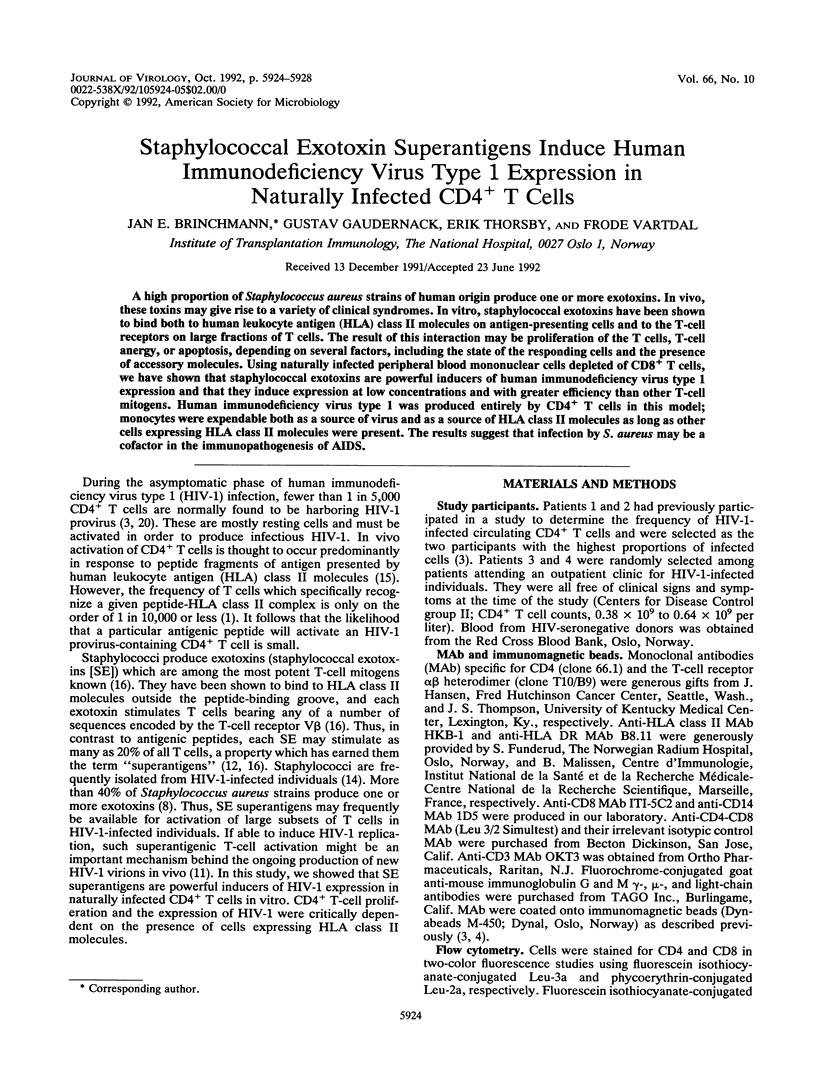
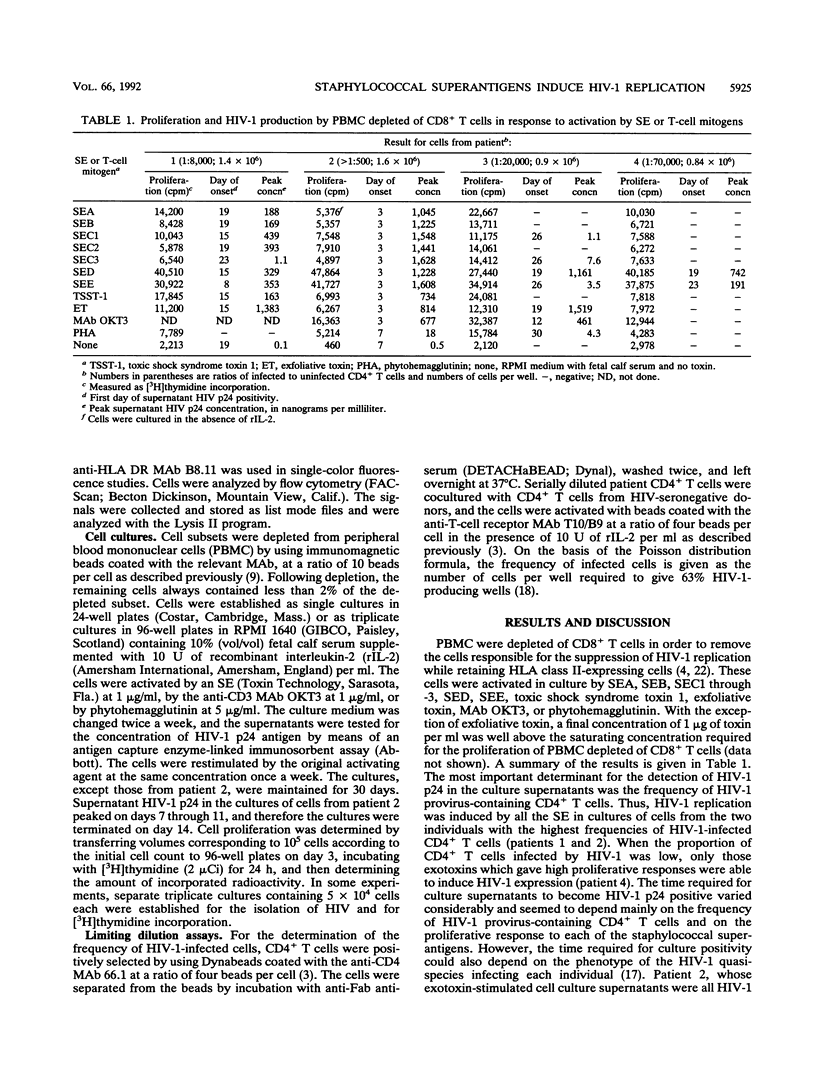
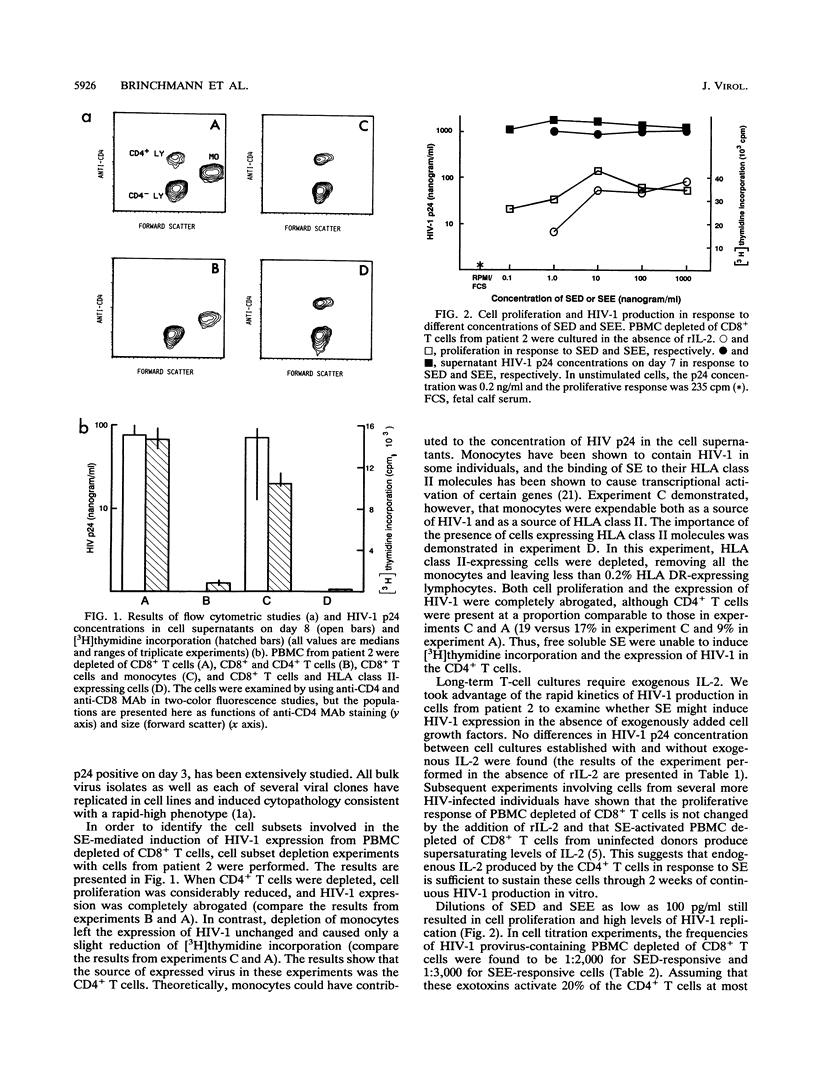
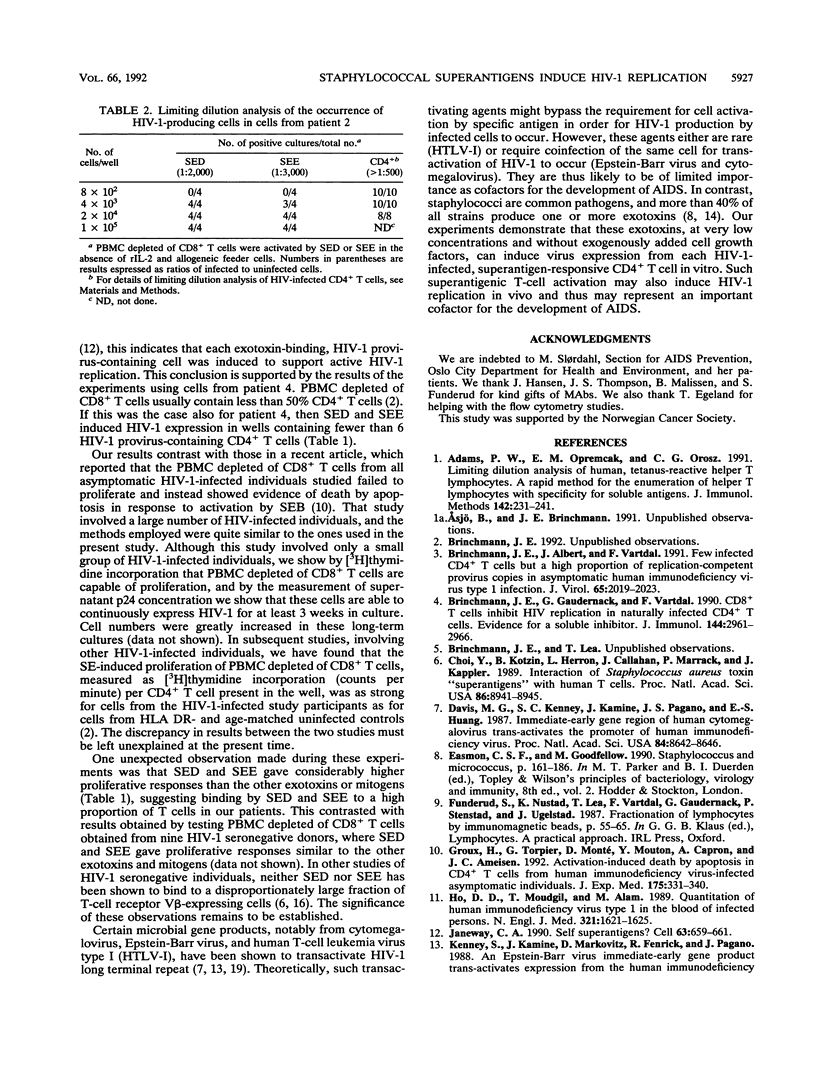
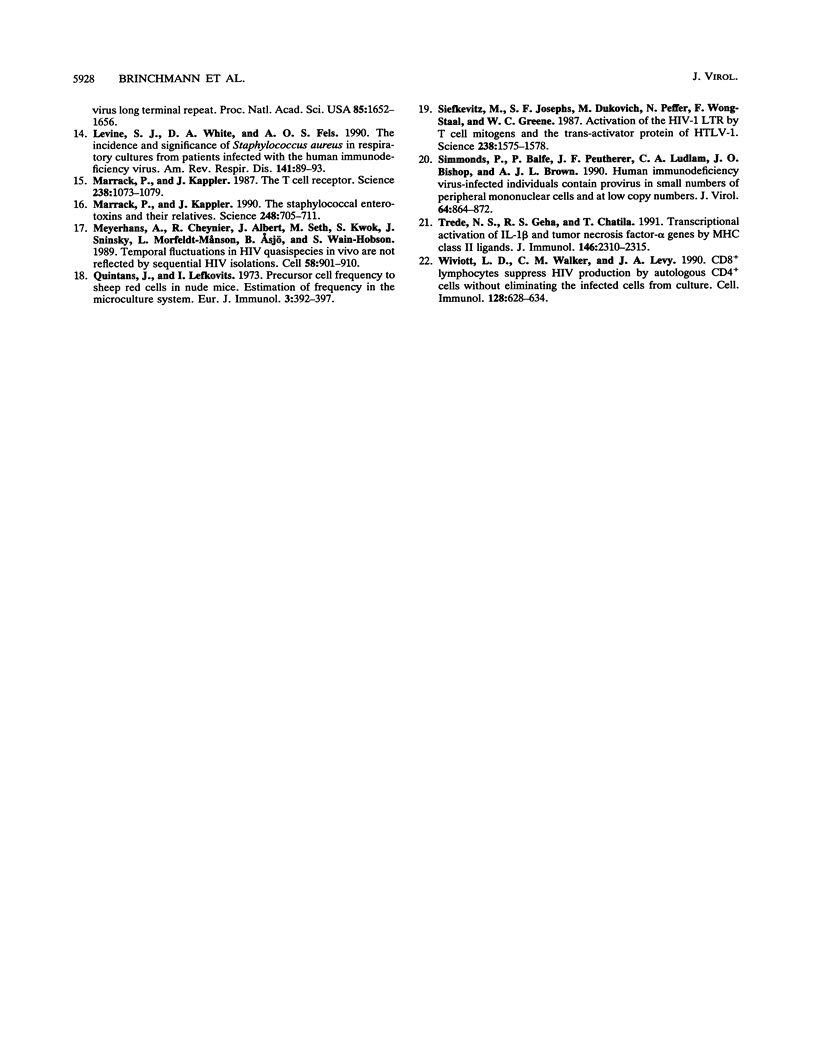
Selected References
These references are in PubMed. This may not be the complete list of references from this article.
- Adams P. W., Opremcak E. M., Orosz C. G. Limiting dilution analysis of human, tetanus-reactive helper T lymphocytes. A rapid method for the enumeration of helper T lymphocytes with specificity for soluble antigens. J Immunol Methods. 1991 Sep 13;142(2):231–241. doi: 10.1016/0022-1759(91)90111-r. [DOI] [PubMed] [Google Scholar]
- Brinchmann J. E., Albert J., Vartdal F. Few infected CD4+ T cells but a high proportion of replication-competent provirus copies in asymptomatic human immunodeficiency virus type 1 infection. J Virol. 1991 Apr;65(4):2019–2023. doi: 10.1128/jvi.65.4.2019-2023.1991. [DOI] [PMC free article] [PubMed] [Google Scholar]
- Brinchmann J. E., Gaudernack G., Vartdal F. CD8+ T cells inhibit HIV replication in naturally infected CD4+ T cells. Evidence for a soluble inhibitor. J Immunol. 1990 Apr 15;144(8):2961–2966. [PubMed] [Google Scholar]
- Choi Y. W., Kotzin B., Herron L., Callahan J., Marrack P., Kappler J. Interaction of Staphylococcus aureus toxin "superantigens" with human T cells. Proc Natl Acad Sci U S A. 1989 Nov;86(22):8941–8945. doi: 10.1073/pnas.86.22.8941. [DOI] [PMC free article] [PubMed] [Google Scholar]
- Davis M. G., Kenney S. C., Kamine J., Pagano J. S., Huang E. S. Immediate-early gene region of human cytomegalovirus trans-activates the promoter of human immunodeficiency virus. Proc Natl Acad Sci U S A. 1987 Dec;84(23):8642–8646. doi: 10.1073/pnas.84.23.8642. [DOI] [PMC free article] [PubMed] [Google Scholar]
- Groux H., Torpier G., Monté D., Mouton Y., Capron A., Ameisen J. C. Activation-induced death by apoptosis in CD4+ T cells from human immunodeficiency virus-infected asymptomatic individuals. J Exp Med. 1992 Feb 1;175(2):331–340. doi: 10.1084/jem.175.2.331. [DOI] [PMC free article] [PubMed] [Google Scholar]
- Ho D. D., Moudgil T., Alam M. Quantitation of human immunodeficiency virus type 1 in the blood of infected persons. N Engl J Med. 1989 Dec 14;321(24):1621–1625. doi: 10.1056/NEJM198912143212401. [DOI] [PubMed] [Google Scholar]
- Janeway C. A., Jr Self superantigens? Cell. 1990 Nov 16;63(4):659–661. doi: 10.1016/0092-8674(90)90130-7. [DOI] [PubMed] [Google Scholar]
- Levine S. J., White D. A., Fels A. O. The incidence and significance of Staphylococcus aureus in respiratory cultures from patients infected with the human immunodeficiency virus. Am Rev Respir Dis. 1990 Jan;141(1):89–93. doi: 10.1164/ajrccm/141.1.89. [DOI] [PubMed] [Google Scholar]
- Marrack P., Kappler J. The T cell receptor. Science. 1987 Nov 20;238(4830):1073–1079. doi: 10.1126/science.3317824. [DOI] [PubMed] [Google Scholar]
- Marrack P., Kappler J. The staphylococcal enterotoxins and their relatives. Science. 1990 May 11;248(4956):705–711. doi: 10.1126/science.2185544. [DOI] [PubMed] [Google Scholar]
- Meyerhans A., Cheynier R., Albert J., Seth M., Kwok S., Sninsky J., Morfeldt-Månson L., Asjö B., Wain-Hobson S. Temporal fluctuations in HIV quasispecies in vivo are not reflected by sequential HIV isolations. Cell. 1989 Sep 8;58(5):901–910. doi: 10.1016/0092-8674(89)90942-2. [DOI] [PubMed] [Google Scholar]
- Quintáns J., Lefkovits I. Precursor cells specific to sheep red cells in nude mice. Estimation of frequency in the microculture system. Eur J Immunol. 1973 Jul;3(7):392–397. doi: 10.1002/eji.1830030704. [DOI] [PubMed] [Google Scholar]
- Siekevitz M., Josephs S. F., Dukovich M., Peffer N., Wong-Staal F., Greene W. C. Activation of the HIV-1 LTR by T cell mitogens and the trans-activator protein of HTLV-I. Science. 1987 Dec 11;238(4833):1575–1578. doi: 10.1126/science.2825351. [DOI] [PubMed] [Google Scholar]
- Simmonds P., Balfe P., Peutherer J. F., Ludlam C. A., Bishop J. O., Brown A. J. Human immunodeficiency virus-infected individuals contain provirus in small numbers of peripheral mononuclear cells and at low copy numbers. J Virol. 1990 Feb;64(2):864–872. doi: 10.1128/jvi.64.2.864-872.1990. [DOI] [PMC free article] [PubMed] [Google Scholar]
- Trede N. S., Geha R. S., Chatila T. Transcriptional activation of IL-1 beta and tumor necrosis factor-alpha genes by MHC class II ligands. J Immunol. 1991 Apr 1;146(7):2310–2315. [PubMed] [Google Scholar]
- Wiviott L. D., Walker C. M., Levy J. A. CD8+ lymphocytes suppress HIV production by autologous CD4+ cells without eliminating the infected cells from culture. Cell Immunol. 1990 Jul;128(2):628–634. doi: 10.1016/0008-8749(90)90054-u. [DOI] [PubMed] [Google Scholar]


